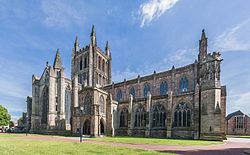Hereford Cathedral
| Hereford Cathedral | |
|---|---|
| Cathedral Church of St Mary the Virgin and St Ethelbert the King |
|

Hereford Cathedral from the north-west
|
|
| Coordinates: 52°03′15″N 2°42′58″W / 52.0542°N 2.7160°W | |
| Location | Hereford, Herefordshire |
| Country | England |
| Denomination | Church of England |
| Website | www.hereford cathedral.org |
| Architecture | |
| Previous cathedrals | 1 |
| Style | Gothic (Early English) |
| Years built | 1079-c.1250 |
| Specifications | |
| Length | 104.2m |
| Nave length | 48.2 |
| Choir length | 22.9 |
| Nave width | 22.3m |
| Width across transepts | 78m |
| Height | 50.3m |
| Nave height | 19.5m |
| Choir height | 19m |
| Number of towers | 1 |
| Tower height | 50.3m |
| Administration | |
| Diocese | Hereford (since 680) |
| Province | Canterbury |
| Clergy | |
| Dean | Michael Tavinor |
| Precentor | Andrew Piper |
| Canon(s) | Chris Pullin, Canon Chancellor Kay Garlick, Cathedral Chaplain |
The current Hereford Cathedral, located at Hereford in England, dates from 1079. Its most famous treasure is Mappa Mundi, a mediaeval map of the world dating from the 13th century. The cathedral is a Grade I listed building.
The cathedral is dedicated to two patron saints, namely Saint Mary the Virgin and Saint Ethelbert the King. The latter was beheaded by Offa, King of Mercia in the year 792. Offa had consented to give his daughter to Ethelbert in marriage: why he changed his mind and deprived him of his head historians do not know, although tradition is at no loss to supply him with an adequate motive. The execution, or murder, is said to have taken place at Sutton, four miles (6 km) from Hereford, with Ethelbert's body brought to the site of the modern cathedral by 'a pious monk'. At Ethelbert's tomb miracles were said to have occurred, and in the next century (about 830) Milfrid, a Mercian nobleman, was so moved by the tales of these marvels as to rebuild in stone the little church which stood there, and to dedicate it to the sainted king.
Before this, Hereford had become the seat of a bishopric. It is said to have been the centre of a diocese as early as the 6th century. In the 7th century the cathedral was refounded by Putta, who settled here when driven from Rochester by Æthelred of Mercia. The cathedral of stone, which Milfrid raised, stood for some 200 years, and then, in the reign of Edward the Confessor, it was altered. The new church had only a short life, for it was plundered and burnt in 1056 by a combined force of Welsh and Irish under Gruffydd ap Llywelyn, the Welsh prince; it was not, however, destroyed until its custodians had offered vigorous resistance, in which seven of the canons were killed.
...
Wikipedia

